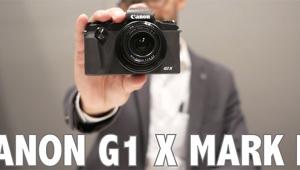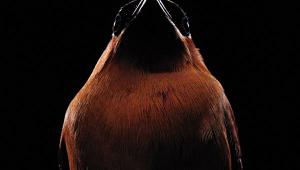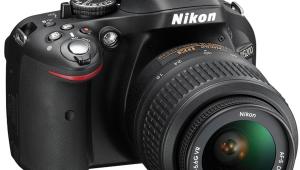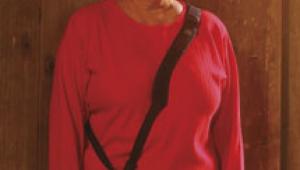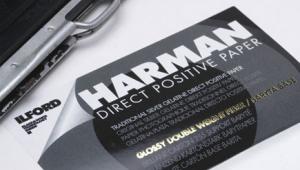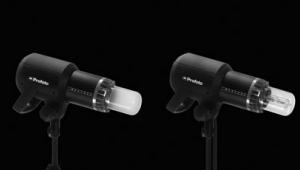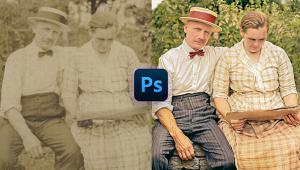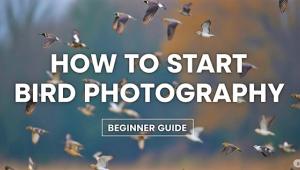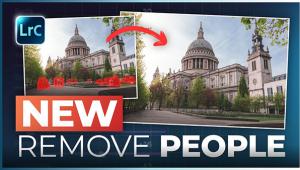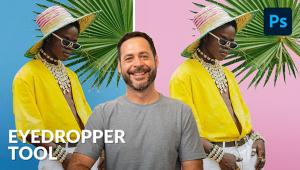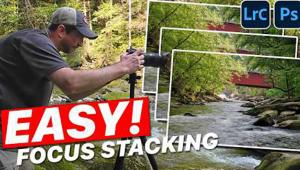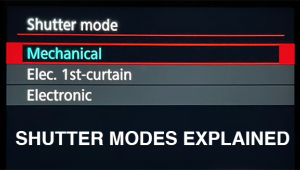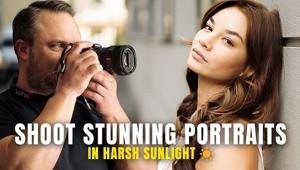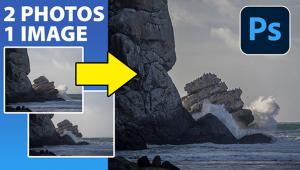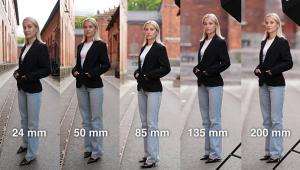photokina: 3D, VR, Dollies & More: Unique Studio Accessories
3D And VR
Robotics, rails, and dollies were the big news at photokina 2012. You could hardly turn a corner without running into cameras that were rolling to and fro on little rails, or going up and down on cranes, or rotating on turntables, or any combination thereof. This trend is driven by two separate requirements. One is stereo photography, now rebranded as 3D, along with its more glamorous sister, Virtual Reality (VR). The other is the ever-increasing use of high-end D-SLRs to shoot video. If you don’t want to make your viewers seasick or give them headaches, you want smooth camera movements. Thus does “kina” (from “cinematography”) creep back into photokina, after an absence of many years.
Although this is unlikely to affect many of us in our own photographic work, we are going to see more and more stereo, VR, and video. This is going to be true from advertising to zoology, taking in entertainment and real estate sales on the way. The Big Name in robotics is still Fotorobot CZ, the Czech company that has led the field for several years, but if you’re in the market for this sort of thing, there is now more and more choice.
Most, like Fotorobot CZ, use step-and-repeat photography. Take a picture; move the camera, or the subject, or both; take another picture; keep shooting. The simplest, because you can rely on gravity to keep the camera on the rails, is left-right, or to-and-fro, a simple rolling motion. Up-down requires a crane, and then there’s rotation. As a general rule, it’s easier to rotate the subject than to run the camera around it on a little circular track, so that’s what most manufacturers do. As well as some new floor-mounted turntables, and a device which (rather eerily) had a pair of empty trousers rotating in midair while hanging from near-invisible wires, Fotorobot CZ also had their standard giant turntable on the stand: 5m (16 feet) diameter, 4 tons maximum load, and just 78mm (a whisker over 3”) high.
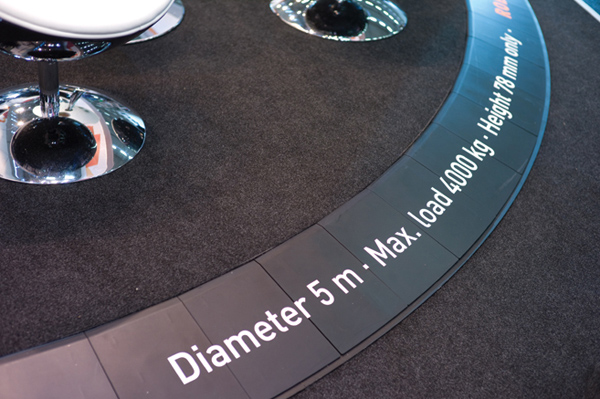
Multi-Cam Setups
Another possibility, as adopted by PackshotCreator, is to use multiple cameras. At the extreme, you surround the subject with cameras, but a more realistic approach is to put several cameras on a gantry, one above the other, and then (once again) rotate the subject. It’s quicker, and it’s arguably less expensive: you need several cameras, it’s true, but the gantry doesn’t move, and all you need is a turntable.
Despite the proliferation of new machinery, we can dismiss robotics fairly quickly for the purposes of this report. Many of the companies are small or new. Inevitably, some will flourish; others will wither and die; and yet other new companies will spring up. If you need this sort of technology, there are two things to look out for. One is whether a given company can meet your specific needs, either off-the-shelf or with something custom-made. The other is whether they are likely to stay in business. I’ve listed the websites of some of those who caught my eye.

All Photos © Roger Hicks Ltd.
Cranes
Rather more elaborate, but fairlylow tech, are the various non-powered(or rather, human-powered) cranesthat are used both for still photography, where a high viewpoint is required, and for video photography. These vary widely in sophistication and smoothness: obviously, smoothness is far more important in video, but it’s easier and more convenient for still photography as well. The ones from Slidekamera in Poland appeared to be well made and versatile, and are modular: there are two crane arms, for example, that are designed to mount on tripods. There were others, though: as so often, it’s likely to be a question of availability where you live. See also Skier and (for dolly track) Foba.
From their website (I forgot to ask them at the show), Slidekamera doesn’t appear to have US distribution, but this doesn’t necessarily matter anymore. After all, you can buy pretty much anything from pretty much anywhere, over the Internet, and even if you can’t get your hands on it beforehand, with big-ticket items like cranes, you can get a pretty good idea of the company (from talking to them or e-mailing them) and of the quality (from web reviews). The main concern is likely to be shipping and customs charges, neither of which seems to be especially predictable.
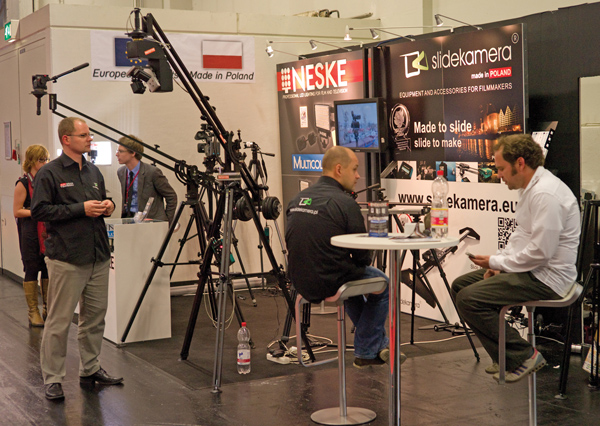
Background Stand Accessories
Also in the low-tech realm, a very simple but very useful innovation is Lastolite’s new articulated joint on their background stands. Anyone who has used rigid background stands will know that if one end of the background roll support is significantly higher than the other, one upright (or both) will usually tip over. If you’re lucky, you’ll just crumple some expensive background paper. If you’re unlucky, the toppling stand will smash something, and if you’re really unlucky, it will injure someone. Lastolite gets around this with a deceptively simple pinned joint which flexes to accommodate differences in height. I don’t shoot much against paper “sweeps” anymore, and besides, I’ve a couple of eyebolts in the wall so I can tie the tops of the stands to the wall with pieces of string. They can still fall, but they can’t fall far. But if I used sweeps more, or if I didn’t have the eyebolts, I’d buy this setup like a shot.

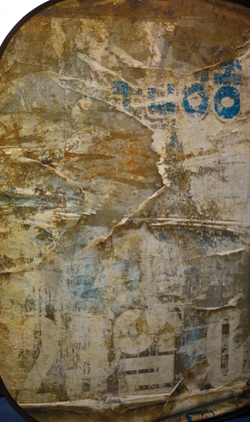
Backdrops
Lastolite also had some interesting new backdrops on their well-known spring-hoop frames, easily tall enough and wide enough for full-length portraits: at a guess, about 4x8 feet, 120x240cm. One that intrigued me was a sort of “urban explorer” effect, all faded graffiti and torn posters. It looked astonishingly three-dimensional. I actually reached out to touch it to confirm that it was just a printed image. In one sense, it’s tacky and faux. In another, it’s brilliant. If you can find the real thing, it will weather and change, and it is unlikely to be in the most salubrious part of town: do you really want to drag your model(s) and your kit to that sort of location, quite apart from the fact that it might be raining? Given that photography is often about fakery and illusion anyway, I don’t have any great moral problem with using this sort of backdrop.
Savage also had some interesting backdrops, designed to be used on the floor as well as on the wall: they call them Floor Drops. Being made of 1.5mm (1/16”) polyester, they’re tough: maximum size is 8 feet (2.44 meters) square. Although most photographers need backdrops far more than they need floor-level backgrounds, there are times when something does have to go on the floor, and these are an excellent idea. It’s important to remember, after all, that backgrounds/backdrops are exactly what their name suggests. They are not the principal subject. At their best, they are completely unmemorable, because they seem like the natural, perfect background to the subject. Used right, both Lastolite and Savage backdrops fulfill this requirement perfectly.
Savage is of course an American company, and a regular at the show, but another well-established American company that I saw for the first time at photokina 2012 was Rosco Laboratories. Rosco is better known in the cine business than in still photography, but this is very much the still photographer’s loss. Since I discovered black Cinefoil, a sort of ultra-heavy, matte black aluminum foil, I’ve found countless uses for it, improvising flags, gobos, snoots, and more. It looks expensive, but a roll lasts halfway to forever, and once you’ve used it, you’ll never want to be without it. Go to their site for an immense range of really useful products, many of which you probably never knew existed.
Dollies
Another low-tech/high-tech company, with a very dynamic and energetic proprietor, Dr. Harald Gorr, was Xhia. Despite the name, this is a German company from Nordhessen and the center of his system is what he calls the “V-concept.” It begins literally with a V-shaped, um, thing, which from the look of it is CNC machined from a block of light alloy. By bolting bits on, Meccano-fashion, you can make video supports, still camera tables, and arguably the smallest, cleverest set of dolly wheels I have ever seen. In one version, two wheels are parallel, while the third is at right angles to them (you REALLY need to see a picture here). Lift the “odd” wheel, and you can roll it to and fro. Drop the “odd” wheel, and it can rotate on its own axis, but it won’t go anywhere else. Is this studio equipment, a camera support, or an accessory? You’ll have to decide for yourself.
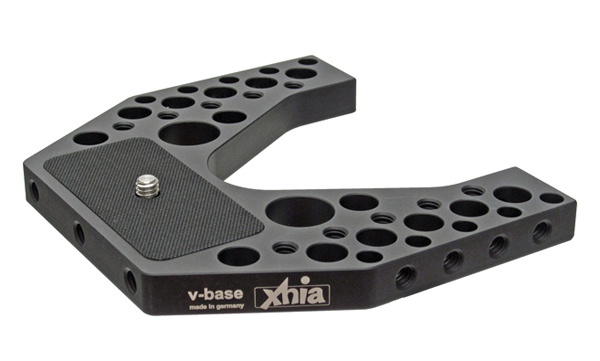
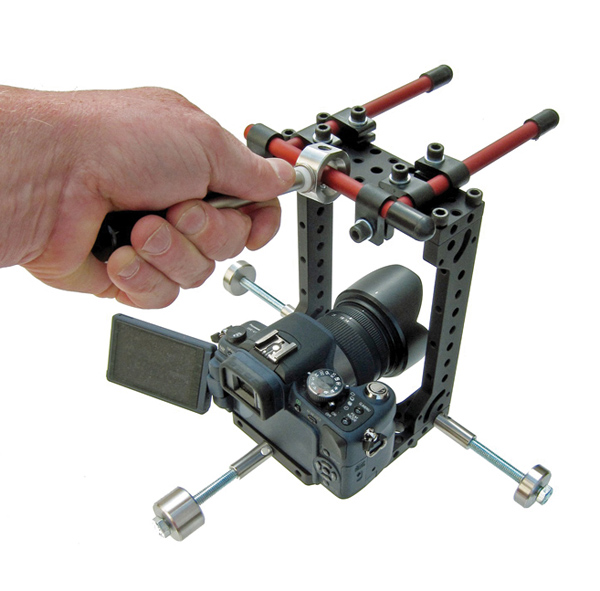

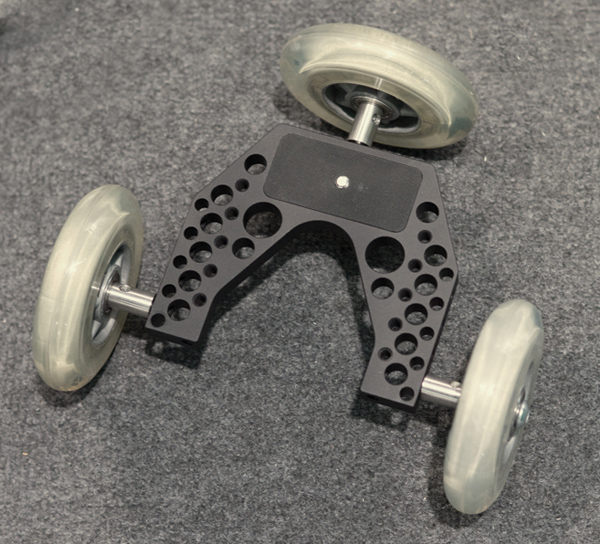
Combining Gear
The last product I’d like to mention in the studio department is a combination camera bag, equipment trolley, camera support, and shooting platform from Redged (the tripod makers) and Clik Elite (the bag manufacturers). I couldn’t quite figure out where to put it, because it falls into so many categories, but eventually I decided that it is pretty much a portable studio: everything you need except the building. With it, you could walk into any suitable space and, in a few minutes, transform it into a working studio.
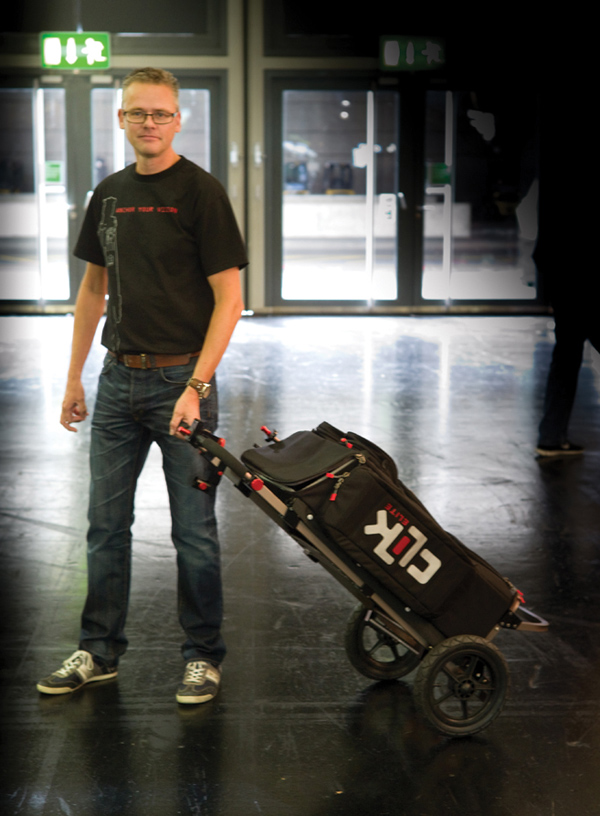
The only real way to explain it is with the aid of two pictures, one of it folded, and one of it in use, with Frances climbing on it. It can carry any reasonable amount of camera gear and lighting, and it is its own camera stand and shooting platform. At the side of the black bag at the front you can see two posts that are designed to be fixed to the telescopic handle-cum-camera support next to Frances’s right hand, for extra stability and rigidity.
In fact, this is an important point about all studio gear, which applies to a lesser extent to lighting. Cameras and lenses are seductive. There’s always the feeling that you may be able to do something new with a new camera or lens that you can’t do with your existing kit. For most photographers, most of the time, this is simply untrue. Most people will get far more mileage out of thinking hard about what they want to do, and from buying studio equipment and lighting, than from endlessly trading in their cameras and lenses.
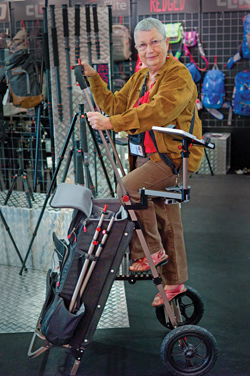
Robotics Websites
Ditogear: www.ditogear.com
dji-innovations: www.dji-innovations.com
Fotorobot CZ: www.fotorobot.cz
PackshotCreator: www.packshot-creator.com
TopScan3D: www.topscan3d.net
Zewide: www.zewide.com
To contact any of the manufacturers listed in this article simply type the boldfaced names into a Search engine and you will be brought to their site. If you have any difficulty contact us at editorial@shutterbug.com and we will do our best to connect you.—Editor




